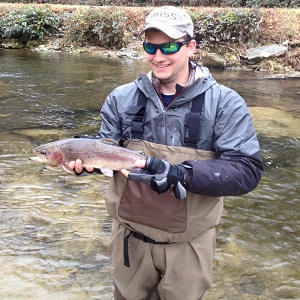 Everyone knows when the weather begins to warm up so does the fishing. So be prepared when you hop into the river with the right dry flies and presentation. Once you step into any river around Asheville, North Carolina on a warm sunny day, you will begin to see a number of different bugs hatching on the surface and flying through the air. When dry fly fishing in spring, presentation is critical to catching the bigger trout. In this article Southern Appalachian Anglers of Asheville will talk about a variety of different techniques to use and what type of fly is predominant in the spring months.
Everyone knows when the weather begins to warm up so does the fishing. So be prepared when you hop into the river with the right dry flies and presentation. Once you step into any river around Asheville, North Carolina on a warm sunny day, you will begin to see a number of different bugs hatching on the surface and flying through the air. When dry fly fishing in spring, presentation is critical to catching the bigger trout. In this article Southern Appalachian Anglers of Asheville will talk about a variety of different techniques to use and what type of fly is predominant in the spring months.
Dry Flies for Early Spring
Early spring you will find a number of different bugs hatching above the waterline. Most of these bugs will be smaller than usual and some will be hard to distinguish from others. There are a number of bugs that will hatch this time of year, from March to April, and Southern Appalachian Anglers will help you try to distinguish one from the other. Most of the early spring pattern dry flies have a history that dates back to the the early 1900’s in the Catskills. Many of the flies that you will be using during the spring months in Western North Carolina and Eastern Tennessee will consist of Mayfly variations.
Fly Patterns in Early Spring
Blue Winged Olives – Size 16 – 20. A very important part of the mayfly hatch. These small dark flies can be used year round, but flourish during the colder months in early spring. Best used on overcast days.
Quill Gordon – Quill body patterns take us back in time to British tiers. With a natural pattern of light and dark colors, this dry fly can be spotted a little easier than the blue winged olive. Works great in early April and once the pleuralis is hatched there will be a consistency of this hatch so keep one tied on!
Blue Quill – A rather dark mayfly variation. Also named Mahogany Duns; this hatch is typically the first to hatch in spring and the last to finish in fall. The blue quill can be deadly on trout all spring long.
Hendrickson – This hatch is probably one of the most commonly known hatch in the country. With trout gorging themselves for mayflies, the hendrickson is definitely a fly worth tying on. Common hatches are in the warmer days. When the weather gets above 55F make sure to tie on an unforgettable hendrickson.
March Brown – Probably the most famous of all British mayflies. The brown to light brown color is proven in the Southern Appalachian mountains and the Northern Appalachian mountains as well. Best used in the beginning stages of spring, when the mayfly starts to emerge.
By utilizing these flies in the spring, trout fishing will become easier. These flies mentioned above are proven methods to catching big trout in the start of the season. Make sure to try some of these patterns out when fly fishing in Asheville and Western North Carolina this year!
Contact Us
To learn more about fly fishing in Asheville, North Carolina, contact Southern Appalachian Anglers Guide Service of Asheville.
